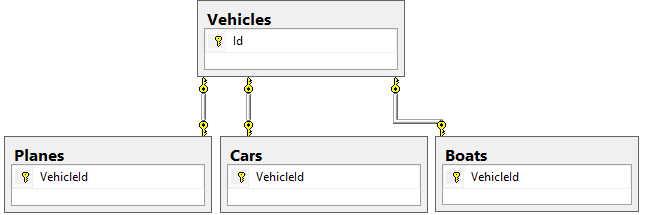I am working with a legacy system that implements a TPH for a certain number of items. So the current structure looks like this
Abstract Class 1 Abstract Class 2 Abstract Class 3
| | |
--------- --------- ---------
| | | | | | | | |
T1 T2 T3 T4 T5 T6 T7 T8 T9
So Type (T*) is a discriminator across all tables but since certain types share common columns, there are a significant number of different tables. The problem is that all of these items actually share a small commonality but there is no way to gather all of these items into a collection. In reality the hierarchy actually should look more like this.
--------------- Base Abstract 1 ----------
| | |
Abstract Class 1 Abstract Class 2 Abstract Class 3
| | |
--------- --------- ---------
| | | | | | | | |
T1 T2 T3 T4 T5 T6 T7 T8 T9
So essentially what we have is a TPT where each Table per type is a TPH. For a real world example, here is what we need.
--------------- Vehicle ---------------
| | |
Car Boat Plane
| | |
--------- --------- ---------
| | | | | | | | |
BMW Toyota Fiat T4 T5 T6 T7 T8 T9
Obviously there are some design flaws with the initial design and no one anticipated needing to grab a list of all vehicles without querying 3 different tables. So my question is, with the existing structure is there a way add this new hierarchy to entity framework. I was thinking something like this
Vehicle
-------
VehicleId
TypeId (Boat, Plane, Car, etc)
ItemFK (BoatID, PlaneId, CarId)
Is this possible? Is there a way to map these in entity framework? I cant seem to match them correctly. It seems it could possibly work if we were to replace BoatId, PlaneId, and CarId with VehicleId (like Conditional Mapping in Entity Framework - OR operation with TPH) but at that point we would be doing a really invasive schema change which is not really an option and I'm not sure that would even work. Essentially I need a way to map existing keys into a new hierarchy. Any help is greatly appreciated. I'm at a loss and can't seem to find any solution that answers my question.


Vehicle,Car, etc, are tables andBMW...Txare discriminators? – Privy